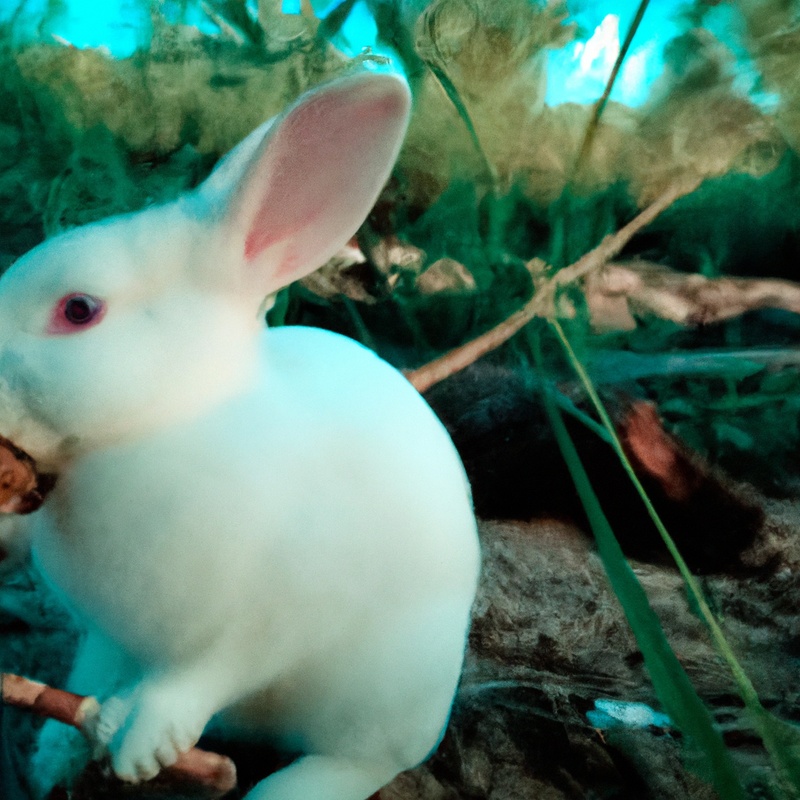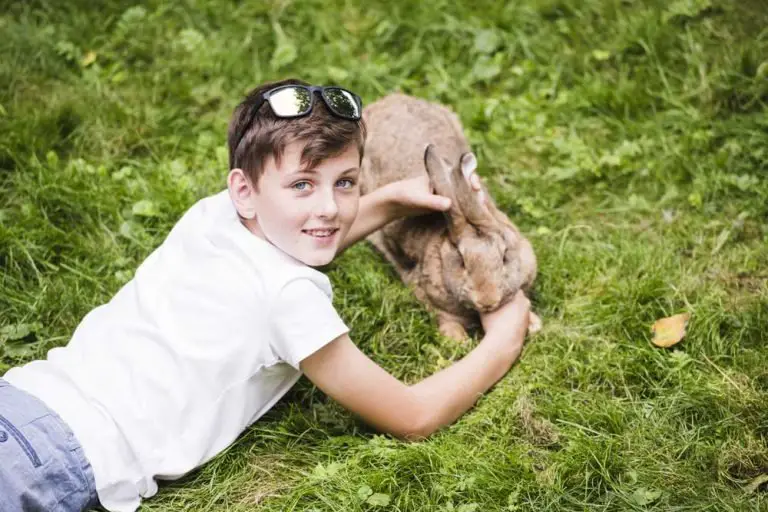How Do Rabbits See The World – Through a Bunny’s Eyes
Key Takeaways:
- Rabbits have a wide field of vision, allowing them to see almost 360 degrees around them.
- Rabbits have excellent motion detection skills, enabling them to spot predators quickly.
- Rabbits can’t see well in the dark and rely on their acute hearing and sense of smell.
- Rabbits have a specialized structure of their eyes that allows for panoramic vision while reducing their ability to perceive depth.
Ever wondered how rabbits perceive the world around them? With their adorable twitching noses and enchanting eyes, these furry creatures have a unique perspective on life.
In this article, we will delve into the captivating world of rabbit vision.
You’ll learn about the fascinating structure of their eyes, their visual abilities, and whether they can see in color or in the dark. We’ll also explore how rabbits utilize their vision in the wild and provide tips on vision care for pet rabbits.
So hop aboard as we uncover the secrets behind how rabbits see the world!
| Aspect | Rabbit’s Vision |
|---|---|
| Color Vision | Limited – Rabbits have dichromatic vision and are unable to see certain colors such as red and green. They primarily perceive blues and greens. |
| Field of View | Panoramic – Rabbits have a wide field of view, approximately 360 degrees, due to their eyes being positioned on the sides of their head. |
| Depth Perception | Poor – Rabbit’s depth perception is not as developed as in humans or predators. Their field of vision hampers their ability to judge distances accurately. |
| Visual Acuity | Poor – Rabbits have relatively poor visual acuity and struggle with fine details. They rely more on motion detection. |
| Nocturnal or Diurnal | Crepuscular – Rabbits are most active during the dusk and dawn periods, making them crepuscular animals. |
| Eye Shape | Laterally Positioned – Rabbit’s eyes are laterally positioned on the sides of their head, providing them with good peripheral vision. |
| Predator Detection | Good – Rabbits are adept at detecting predators due to their wide field of view and ability to detect slightest movements. |
Understanding Rabbit Vision: How Do Rabbits See the World?
Ever wondered how rabbits see the world? Let’s dive into the fascinating world of rabbit vision.
Structure of a Rabbit’s Eye
The structure of a rabbit’s eye is fascinating. It has large, protruding eyes on the sides of its head, providing them with a wide range of vision.
Rabbits have nearly 360-degree panoramic vision, which helps them detect predators from all directions.
The position of their eyes also allows for excellent peripheral vision. Their eyes are typically positioned high on their head, enabling them to see above tall grasses and other obstacles.
Additionally, rabbits have a special adaptation called a “nictitating membrane,” which helps protect their eyes from dust and debris.
Overall, a rabbit’s eye structure allows them to be highly aware of their surroundings and stay safe in their habitat.
Visual Abilities of Rabbits
Rabbits have excellent vision, allowing them to navigate their surroundings with ease. Here are some key aspects of their visual abilities:
- Peripheral Vision: Rabbits have a wide field of view, around 360 degrees, thanks to their eyes being positioned on the sides of their head. This gives them a great sense of awareness about their surroundings and helps them detect potential threats.
- Night Vision: While not fully nocturnal, rabbits have good night vision. They possess a high number of rod cells in their eyes, which are specialized for low-light conditions. This helps them see better in dimly lit environments.
- Color Perception: Although not as vibrant as that of humans, rabbits can perceive various colors. They have a slightly limited range of color perception, with a preference for colors on the blue-green spectrum.
- Depth Perception: Due to the position of their eyes, rabbits have overlapping visual fields, which allows them to have fairly accurate depth perception. This helps them judge distances accurately, particularly when leaping and navigating obstacles.
- Quick Eye Movements: Rabbits have the ability to move their eyes rapidly and independently, allowing them to scan their surroundings efficiently. This helps them detect movement and potential threats more effectively.
Understanding the visual abilities of rabbits can give us insight into how they perceive the world around them. With their wide field of view, night vision, color perception, depth perception, and quick eye movements, rabbits have developed sensory capabilities that allow them to thrive in their natural habitats.

Color Vision in Rabbits
Rabbits have limited color vision compared to humans.
They primarily see blues and greens, but their ability to perceive reds and yellows is less developed.
This is because rabbits have fewer color-detecting cells, known as cones, in their eyes.
However, they excel at detecting motion and have excellent night vision.
Rabbits rely more on their acute sense of smell and hearing to navigate their environment, but they can still appreciate the beauty of nature in their own unique way.

Depth Perception in Rabbits
Rabbits have limited depth perception due to the position of their eyes on the sides of their head.
This means that they struggle with judging distance and may have difficulty navigating obstacles.
However, rabbits compensate for this by relying on their other senses, such as their acute hearing and sense of smell.
They also have a wide field of vision, allowing them to detect potential predators.
Depth perception is not a strong suit for rabbits, but they have developed other strategies to navigate their environment.
Field of Vision in Rabbits
Rabbits have a field of vision of approximately 360 degrees.
This means they can see almost all around themselves without having to turn their heads.
However, their vision is strongest in the areas directly in front of them.
This wide field of vision helps them to be alert to potential threats and predators.
Rabbits also have a blind spot right in front of their noses, so they rely on their whiskers to navigate close spaces.
Due to their wide field of vision, rabbits have excellent peripheral vision, making them very observant and able to detect movement from a distance.

Night Vision in Rabbits
Rabbits have exceptional night vision. They possess a high number of rod cells in their eyes, which are specialized for low-light conditions.
This allows them to see well in dim lighting, making them adept at navigating in the dark.
Additionally, rabbits have a wide field of view, allowing them to detect predators from various angles. They also have the ability to detect motion quickly, contributing to their survival in the wild.
Overall, rabbits’ night vision is a remarkable adaptation that enables them to thrive in different lighting conditions.
How Rabbits Utilize Their Vision in the Wild
Rabbits utilize their vision in the wild to stay alert and avoid predators. Their wide-angle vision allows them to see almost 360 degrees, keeping them aware of potential threats from all angles.
Rabbits also have excellent night vision, thanks to their large pupils and tapetum lucidum.
This enables them to navigate in low-light conditions and avoid danger. Additionally, their forward-facing eyes provide binocular vision, which helps them accurately judge distances and speed when escaping from predators.
Rabbits rely heavily on their vision to survive in their natural habitat.
Vision Care for Pet Rabbits
Vision care for pet rabbits is an important aspect of their overall well-being. Here are some tips to ensure your rabbit’s eyes stay healthy:
- Regular veterinary check-ups: Schedule routine visits to your vet to assess your rabbit’s eye health and detect any potential issues early.
- Cleanliness: Keep your rabbit’s living area clean to prevent eye irritants and infections. Regularly remove excess fur, dust, and debris.
- Diet: Provide a balanced diet rich in vitamins and minerals to support your rabbit’s eye health. Fresh vegetables like carrots and leafy greens are great choices.
- Grooming: Regularly groom your rabbit to prevent long fur from obstructing their vision or causing eye irritation. Pay special attention to the fur around their face.
- Observe behavior: Keep an eye out for any changes in your rabbit’s behavior, such as squinting, excessive tearing, or discharge. These could indicate an eye problem and should be addressed promptly.
Remember, just like humans, rabbits rely heavily on their vision. By taking proper care of their eyes, you can help ensure they lead happy and healthy lives.
Frequently Asked Questions about Rabbit Vision
1. How do rabbits see in the dark?
Rabbits have excellent night vision due to their large eyes and a high number of rods in their retinas.
This allows them to see well in low-light conditions and navigate their surroundings.
2. Can rabbits see color?
Yes, rabbits can see color, but their color vision is not as strong as humans’.
They primarily see blues and greens, and their ability to distinguish between different shades is limited.
3. Do rabbits have good depth perception?
Rabbits have decent depth perception, but it is not as developed as in predators.
Their eyes are positioned on the sides of their heads, providing a wide field of view but reducing their overall depth perception.
4. Can rabbits see in all directions?
Yes, rabbits have nearly 360-degree vision, which means they can see behind themselves without even turning their heads.
This helps them detect potential threats and stay alert.
5. Are rabbits nearsighted or farsighted?
Rabbits are farsighted, which means they have trouble seeing objects up close.
They rely more on their keen sense of smell and hearing to navigate their immediate surroundings.
6. Do rabbits have a blind spot?
Yes, rabbits have a small blind spot right in front of their noses.
This is why they will often twitch their noses or tilt their heads to get a clear view of something that is close to them.
7. Can rabbits see in color at night?
Rabbits’ color vision is not as effective in low-light conditions.
While they can still see some colors, their vision becomes more monochromatic, favoring shades of gray.
8. Can rabbits see well during the day?
Yes, rabbits have good vision during the day.
Their eyes are adapted to detect motion, allowing them to spot predators from a distance.
However, their field of vision is slightly limited, and they have a blind spot directly in front of them.
9. Do rabbits have good peripheral vision?
Yes, rabbits have fantastic peripheral vision.
Their eyes are positioned on the sides of their heads, giving them a wide field of view and helping them detect potential threats from different angles.
10. How do rabbits react to light?
Rabbits are sensitive to bright lights and direct sunlight.
They have a natural instinct to seek shaded areas during hot days to protect their eyes from excessive brightness.
FAQ 1: Can rabbits see in the dark?
FAQ 1: Can rabbits see in the dark? Rabbits have excellent night vision, allowing them to see in low light conditions.
They have larger eyes than humans, providing them with a wider field of view.
Additionally, rabbits have a higher concentration of rod cells in their retinas, which are more sensitive to light. This helps them detect movement and navigate in dimly lit areas.
While rabbits cannot see in complete darkness, their eyesight adaptations make them well-suited for activities during dawn and dusk.
FAQ 2: Do rabbits see in color?
Rabbits see in color, but not exactly like we humans do. While humans have three types of color receptors in our eyes (red, green, and blue), rabbits only have two (green and blue).
This means that rabbits cannot distinguish between red and green hues like we can.
Instead, they see a world that is more muted and dominated by blues and greens. However, rabbits have excellent vision in the dark due to their large eyes and ability to detect low levels of light.
FAQ 3: Can rabbits see behind them?
Rabbits have nearly 360-degree vision, which means they have a wide field of view. While they can’t see directly behind them, they do have a blind spot directly in the back of their heads.
This blind spot helps predators approach without being noticed.
However, rabbits compensate for this by using their excellent hearing and agility to detect and escape from any potential threats.
FAQ 4: Can rabbits wear glasses or contact lenses?
No, rabbits cannot wear glasses or contact lenses.
They have different eye structures and sizes compared to humans, making these accessories ineffective for them.
Rabbits rely on other senses, such as their strong sense of smell and excellent peripheral vision, to navigate their surroundings.
If you notice any changes in your rabbit’s vision, it’s best to consult a veterinarian for appropriate care and guidance.
FAQ 5: How far can rabbits see?
Rabbits have pretty good vision and can see up to 360 degrees around them without moving their heads. However, their depth perception isn’t as strong as ours.
Rabbits mainly rely on their sense of smell and hearing to navigate their surroundings and detect potential threats.
So while they can see far enough to spot predators from a distance, they may not accurately judge how far away they are.
Final Verdict
Understanding rabbit vision gives us a fascinating glimpse into how these furry creatures perceive the world around them.
The structure of their eyes, their visual abilities, and their unique traits such as color vision, depth perception, and night vision all contribute to their survival in the wild.
Additionally, it’s important to provide appropriate vision care for pet rabbits to ensure their well-being.
Armed with this knowledge, we can better appreciate and cater to the sensory experience of rabbits, creating a harmonious environment for them.
Remember, rabbits rely heavily on their vision, so let’s help them see the world in the best possible way.







